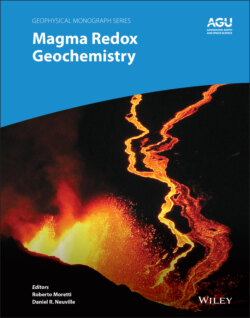Читать книгу Magma Redox Geochemistry - Группа авторов - Страница 50
Degassing.
ОглавлениеObservational studies that have investigated the relationship between degassing and magmatic fO2 have thus far observed reduction of melt Fe3+/∑Fe ratios in response to degassing. For example, numerous XANES studies on natural glasses have captured the potential for sulfur degassing to reduce melt Fe3+/∑Fe ratios (Brounce et al., 2014; Brounce et al., 2017; Hartley et al., 2017; Helz et al., 2017; Kelley & Cottrell, 2012; Moussallam et al., 2016; Moussallam et al., 2014; Moussallam et al.; Shorttle et al., 2015). In order to gain further insight into the effect of C–O–H–S degassing on magmatic fO2, we present results from the gas‐melt equilibrium model D‐Compress of Burgisser et al. (2015) (see Methods Appendix). Detailed explanations of how D‐Compress treats fO2 during degassing can be found in Burgisser et al. (2015), Moussallam et al. (2016), and Brounce et al. (2017). A general feature of the model output is a prediction of modest changes in fO2 (< 0.2 log units), both positive and negative, as degassing proceeds until pressures fall below ~250 bar, at which point fO2 falls sharply in all tectonic settings (Fig. 3.5). D‐Compress therefore predicts that the fO2 of MORB is negligibly affected by degassing (Fig. 3.5, gray line) owing to the fact that MORBs erupt at pressures greater than 200 bar and the dominant degassing volatile is, which has limited power to shift magmatic fO2 so long as the MORB source is more oxidized than graphite saturation (Cottrell and Kelley, 2011). Degassing‐fO2 pathways at arcs and subaerial plume volcanoes have greater potential to shift fO2 because lavas and tephras can degas to 1 atmosphere total pressure. However, melt inclusions may be trapped at nearly any point along the degassing pathway, which may spare some arc and plume sample sets from recording strong modification. Typical water contents of arc melt inclusions yield a conservative estimate of entrapment pressures of 400–3000 bar (Plank et al., 2013). At these entrapment pressures, arc magmas with typical volatile concentrations may be slightly more or less oxidized, but within ~0.2 log units of their source, depending on their initial fO2 (Fig. 3.5). The fact that arc melt inclusions become progressively reduced during degassing (e.g., Helz et al., 2017; Kelley & Cottrell, 2012; Moussallam et al., 2014; Moussallam et al., 2019) strongly indicates that the arc source is significantly more oxidized than MORB (compare teal arc degassing pathways initiated at QFM vs QFM +1.5 in Figure 3.5).
Figure 3.5 Progressive degassing of a C–O–H–S vapor in ridge, arc, and plume settings using the gas‐melt equilibrium model D‐Compress of Burgisser et al. (2015). For the model run shown by the dashed blue curve, we have set the solubility of H2 in silicate melt to zero; this assumption creates no resolvable difference for any of the other curves shown. For DCompress model details, see the Methods Appendix. Model runs marked OIB, Arc, and MORB are intended to mimic the degassing trajectories of typical magmas from each setting (see methods appendix for details). The OIB and arc scenarios were each run at QFM and near QFM +1.5 to demonstrate the impact of initial fO2 on degassing trajectory. Orange shaded field shows estimated entrapment pressures for olivine‐hosted melt inclusions in OIB based on water and CO2 concentrations (Tucker et al., 2019). Teal stippled field shows minimum estimated entrapment pressures for olivine‐hosted melt inclusions considering water concentrations alone (Plank et al., 2013), which will underestimate typical entrapment pressures. Gray shaded field shows eruption pressures for MORB, which are constrained by ridge depth.
The much higher ratios of sulfur to water in undegassed OIB magmas lead to a larger magnitude of reduction as degassing proceeds in OIB settings compared to arc settings, because the reducing effects of degassing ~2000 ppm S are not as strongly offset by the slightly oxidizing effects of degassing H2O, as is the case for H2O‐rich arc magmas (Fig. 3.5, orange lines). The model predictions in Fig. 3.5 that link degassing to reduction are consistent with observations of natural glass and melt inclusion suites, as reviewed above, and implies that the fO2 recorded by plume‐source glasses is typically a minimum (Brounce et al., 2017; Helz et al., 2017; Moussallam et al., 2019). Corroborating evidence is found when we compare the more primitive and less degassed plume glasses (orange circles, Fig. 3.2e) to magnetite–ilmenite oxybarometry in plume lavas (Fig. 3.2f). The latter record lower fO2 on average, and we speculate that this may reflect magnetite and ilmenite crystallization further along the liquid line of descent, after significant degassing. Further, if fractional crystallization acts to oxidize iron in typical plume lavas, its effect is either counterbalanced by degassing or is not on display here as we compare these two proxies. The caveat is that these are global compilations; Fig. 3.2e and 3.2f do not have samples in common, and we need targeted studies to untangle these competing effects.
If we look to the mantle for further insights about plume fO2, we find additional evidence that plumes may be oxidized, but the story remains nuanced. Pyroxenite xenoliths from OIB localities have been interpreted as the products of extensive refertilization of the lithosphere by plume‐derived melts (Sen & Leeman, 1991). The relatively oxidized fO2 recorded by these pyroxenite xenoliths provides further evidence that OIB source regions are more oxidized than the MORB source (Figure 3.3d). The opportunity to investigate the Fe3+/∑Fe ratios of submarine and melt inclusion suites from arcs and plumes holds great future promise for reconstructing primitive melt compositions from partially degassed samples.
